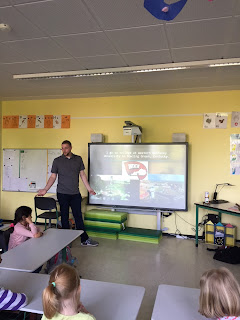After the first couple of weeks I can definitely say that I would be perfectly content with staying in Germany forever and becoming a teacher here. I have been in two different schools so far and they have both been amazing learning experiences. The different school that I was in this week is called Lambertus Schule and it is in a small village called Walstedde.
Another WKU student teacher, Cassidy McCord, and myself were given the opportunity to observe and teach in this school due to it having a special education program. Together, we observed the special education teachers and their students. However, due to the language barrier between us, there was not much we could do in this classroom other than observe. With that being said, we started going to the English classes with the students. Cassidy and I both prepared PowerPoint lessons and taught them on Thursday and Friday about Bowling Green, Kentucky, and the United States of America.
Similarities & differences in our educational system
The main differences I've noticed in Germany between our educational systems is second languages, behavior management, breaks between classes, and the time that school lets out. In Germany it is required that students have at least five years of English and multiple years of other languages as well. Most of the high school students I have worked with know anywhere from 3-5 languages. I honestly wish we did more in America with second languages and didn't just require at least one year of it in high school.
Behavior management is also very different in Germany because the teachers don't really spend time addressing behaviors. Teachers are much more respected in society here and the students know what they can and cannot get away with. Most students will stop their behaviors once they realize the teacher isn't going to give them attention for it. Another reason behavior management is so obsolete is because of my next major difference, breaks between classes.
All of the classes here are between 45-55 minutes long and are taught in pairs. For example, 1st and 2nd period are taught together as the same subject. In between 1st and 2nd period the students will get a 5 minute break, but after the paired periods are over the student get an entire 20 minutes of break time. In this time the students can go outside and play, go to the cafeteria to purchase snacks, listen to music, etc. Then they all return to class and prepare for the next class subject. This repeats for ever paired lesson throughout the day and their are up to 8 periods in a school day. That all depends on what time you get out of school.
School in Germany is not based on an exact schedule for every day like it is in America. Instead of 7:30-3:00 every day, school will release at a different time every day based on the students schedule of classes that they are required to take in their current semester. Some students may leave after 6th period, some leave after lunch, and some leave after 8th period with is around 2:00. Every student has an individual schedule and they know when they can go home. Some students will even go home to have lunch with their family if they get out at 6th period.
With so many differences you can really tell a difference in the amazing atmosphere and performance of the students in these schools. There is more concentration due to more frequent break times to let the students out of the classroom and come back ready to learn. Letting students out earlier but still learning the same amount of material is by far one of my favorite things about school here. But the real cherry on top is the multiple languages taught in school. I am in a foreign country and can teach almost any class I want to in English because the students are so fluent in other languages. Our educational system really seems to be behind when it comes to these great ideas and I hope that more international student teaching from myself, and peers, can shed some light on the gaps between us and help us jump aboard this approach to teaching.


No comments:
Post a Comment